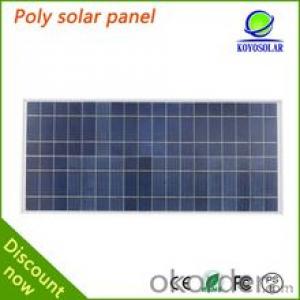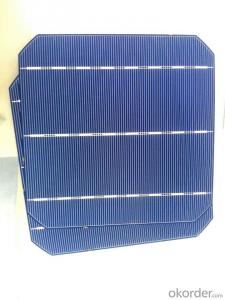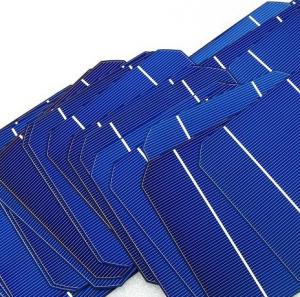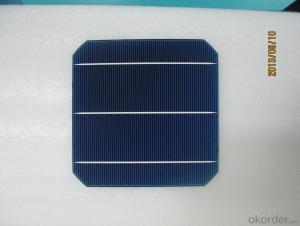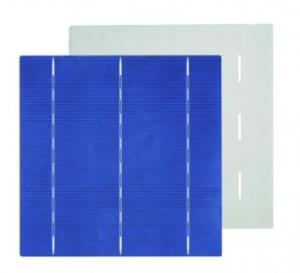Hot Solar Cells - Monocrystal Solar Energy Cell 156*156mm with 18.3% Efficiency
- Loading Port:
- China Main Port
- Payment Terms:
- TT or LC
- Min Order Qty:
- -
- Supply Capability:
- 1000000 PCS/month
OKorder Service Pledge
OKorder Financial Service
You Might Also Like

Monocrystal Solar Energy Cell
type:156M
appearance:156×1565㎜±0.5mm;diagonal:R=100mm
Main fence wide:1.4-1.5mm back electrode wide:2-2.5mm
Fence line qty:90
Cell thickness:220um±20um
Eff(%) | 18.00- 18.10 | 18.10- 18.20 | 18.20- 18.30 | 18.30- 18.40 | 18.40- 18.50 | 18.50- 18.60 | 18.60- 18.70 | 18.70- 18.80 | 18.80- 18.90 | 18.9- 19.0 | 19.1- 19.1 | 19.1- 19.2 |
Pm(W) | 4.30 | 4.33 | 4.35 | 4.37 | 4.40 | 4.42 | 4.44 | 4.47 | 4.49 | 4.52 | 4.54 | 4.56 |
Isc(A) | 8.71 | 8.73 | 8.76 | 8.77 | 8.78 | 8.82 | 8.83 | 8.85 | 8.86 | 8.88 | 8.9 | 8.93 |
Im(A) | 8.19 | 8.21 | 8.24 | 8.26 | 8.30 | 8.33 | 8.35 | 8.39 | 8.42 | 8.45 | 8.47 | 8.51 |
Voc(V) | 0.630 | 0.631 | 0.632 | 0.633 | 0.634 | 0.634 | 0.635 | 0.636 | 0.637 | 0.637 | 0.638 | 0.64 |
Vm(V) | 0.527 | 0.528 | 0.529 | 0.531 | 0.531 | 0.532 | 0.534 | 0.534 | 0.535 | 0.536 | 0.537 | 0.538 |
FF(%) | 78.6 | 78.7 | 78.8 | 79.0 | 79.2 | 79.3 | 79.5 | 79.6 | 79.8 | 80 | 80 | 80 |

remark:our company cells as per working current concentrate principle,separate the first and the second grade
Applications of Polycrystalline Solar Cells
Assemblies of photovoltaic cells are used to make solar modules which generate electrical power from sunlight, as distinguished from a "solar module" or "solar panel". A solar array generates solar power using solar energy.
Factory Picture of Solar Cells

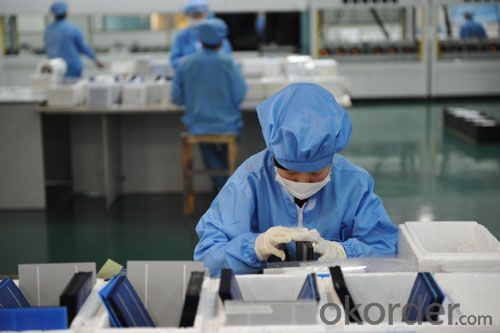
FAQ
We have organized several common questions for our clients,may help you sincerely:
What’s price per watt?
A: It’s depends on the quantity, delivery date and payment terms of the order. We can talk further about the detail price issue. Our products is high quality with lower price level.
Can you tell me the parameter of your solar cells?
We have different series of cells with different power output, both from c-si to a-si. Please take our specification sheet for your reference.
How do you pack your products?
We have rich experience on how to pack the panels to make sure the safety on shipment when it arrives at the destination.
Can you do OEM for us?
Yes, we can.
How long can we receive the product after purchase?
In the purchase of product within three working days, We will arrange the factory delivery as soon as possible. The perfect time of receiving is related to the state and position of customers. Commonly 7 to 10 working days can be served.
- Q: Can solar cells be used in greenhouses or agricultural facilities?
- Yes, solar cells can be used in greenhouses or agricultural facilities to generate clean and renewable energy. This can help reduce reliance on traditional energy sources and lower carbon emissions. Additionally, solar cells can provide a consistent power supply for various agricultural operations, such as lighting, ventilation, and irrigation systems, enhancing productivity and sustainability in these facilities.
- Q: Can solar cells be used on windows?
- Yes, solar cells can be used on windows. Transparent solar panels known as "solar windows" can be installed on windows to generate electricity while still allowing light to pass through. These solar windows are a promising technology for integrating renewable energy generation into buildings.
- Q: What is a High-efficiency electric solar cell panel?
- None of the electric solar cell panel that I bought in the market is really highly efficient because there have been always some quality problems or defects.
- Q: How do solar cells perform in extreme weather conditions?
- Solar cells can generally perform well in extreme weather conditions. However, extreme heat can cause a slight decrease in their efficiency, while extreme cold temperatures can reduce the power output temporarily. Additionally, severe weather events such as hailstorms or strong winds may damage the solar panels if they are not properly installed or protected. Nonetheless, solar cells are designed to withstand these conditions and continue to generate electricity, making them a reliable and sustainable energy source even in extreme weather.
- Q: What is a good introduction of solar cell?
- You should start with a nice ppt.
- Q: Can solar cells be used in grid-tied systems?
- Yes, solar cells can be used in grid-tied systems. In a grid-tied system, solar cells generate electricity from sunlight and feed it directly into the electrical grid. This allows homeowners or businesses to offset their energy consumption and even earn credits for excess electricity produced, making it an efficient and sustainable option for renewable energy integration.
- Q: Can solar cells be used for powering communication towers?
- Yes, solar cells can be used for powering communication towers. Solar energy can be harnessed using photovoltaic cells, which convert sunlight into electricity. These cells can generate power throughout the day, making them a reliable source of energy for communication towers that require continuous operation. Additionally, solar cells can be integrated with batteries to store excess energy for use during nighttime or cloudy periods, ensuring uninterrupted power supply to communication towers.
- Q: Can solar cells be used in indoor applications?
- Yes, solar cells can be used in indoor applications, although their efficiency may be lower compared to outdoor use. Indoor applications typically include powering small electronic devices or providing lighting for indoor spaces.
- Q: Solar cells and the difference between ordinary batteries. Why is the solar cell is converted into electrical energy, zinc battery is what is converted into chemical energy
- Ordinary batteries have a certain life, can not be stored for too long, or the power will slowly run out of solar cells do not exist chemical failure, can be long-term preservation.
- Q: How do solar cells impact energy consumption patterns?
- Solar cells impact energy consumption patterns by providing a renewable and clean source of electricity. They reduce reliance on traditional fossil fuels, decrease greenhouse gas emissions, and promote sustainable energy practices. Solar cells enable individuals, businesses, and communities to generate their own power, leading to a more decentralized and resilient energy system. Additionally, solar energy contributes to a more balanced and diversified energy mix, reducing the strain on conventional power grids and enhancing energy security.
Send your message to us
Hot Solar Cells - Monocrystal Solar Energy Cell 156*156mm with 18.3% Efficiency
- Loading Port:
- China Main Port
- Payment Terms:
- TT or LC
- Min Order Qty:
- -
- Supply Capability:
- 1000000 PCS/month
OKorder Service Pledge
OKorder Financial Service
Similar products
Hot products
Hot Searches
Related keywords










